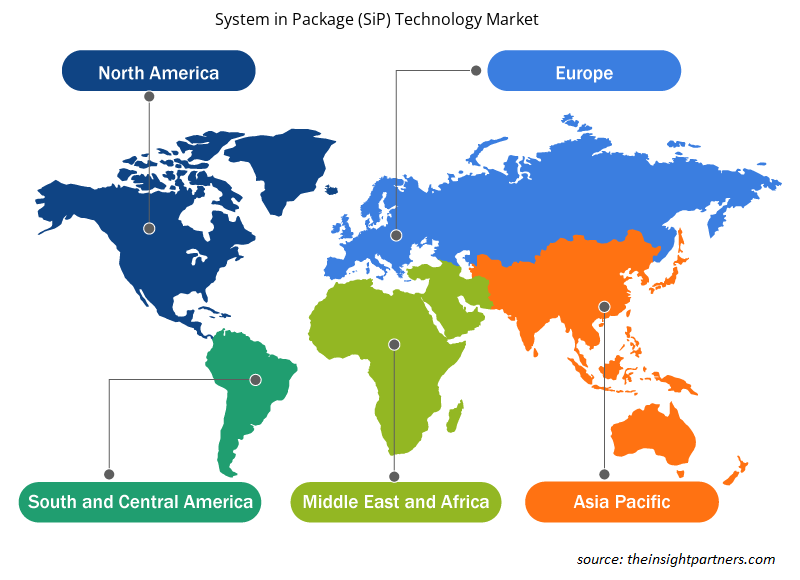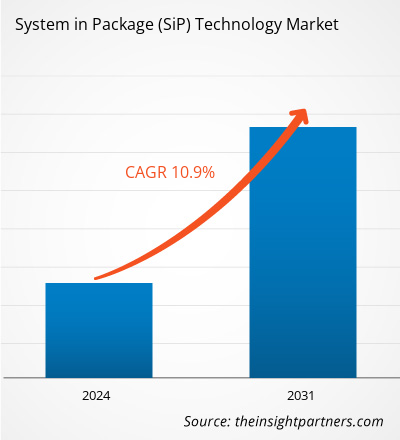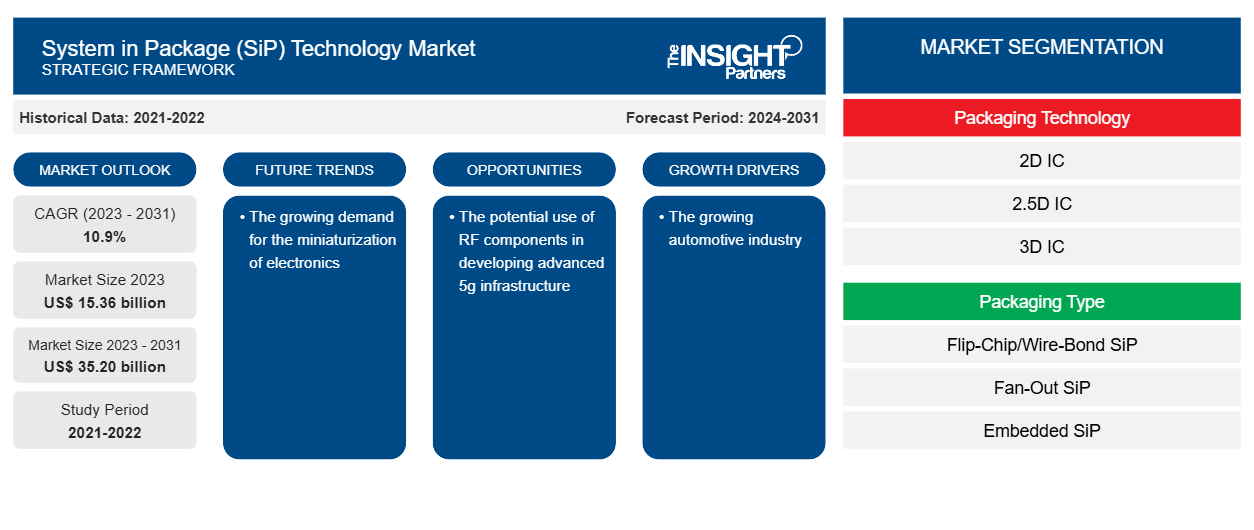Der Markt für System-in-Package-Technologie (SiP) soll von 15,36 Milliarden US-Dollar im Jahr 2023 auf 35,20 Milliarden US-Dollar im Jahr 2031 anwachsen. Der Markt wird voraussichtlich zwischen 2023 und 2031 eine durchschnittliche jährliche Wachstumsrate (CAGR) von 10,9 % verzeichnen. Die wachsende Nachfrage nach Miniaturisierung von Elektronik dürfte ein wichtiger Markttrend für System-in-Package-Technologie (SiP) bleiben.
Marktanalyse für System-in-Package-Technologie (SiP)
Es wird erwartet, dass die Einführung von Geräten mit 5G-Netzwerkverbindung, die gestiegene Nachfrage nach kleinen elektronischen Geräten mit Internetverbindung und die Verbreitung von Geräten des Internets der Dinge (IoT) das Wachstum des globalen Systems-in-Package-Technologiegeschäfts (SiP) vorantreiben werden. Darüber hinaus entwickelt sich die Branche aufgrund der zunehmenden Verwendung von Smartphones und intelligenten Wearables. Höhere Integrationsgrade können jedoch thermische Probleme verursachen, was eine erhebliche Marktbeschränkung darstellt. Umgekehrt wird erwartet, dass die starke Nachfrage aus der Region Asien-Pazifik die Marktexpansion im gesamten prognostizierten Zeitraum unterstützen wird.
Marktübersicht zur System-in-Package-Technologie (SiP)
Die als „System in Package“ (SiP) bekannte Verpackungstechnik integriert eine Reihe passiver und elektrischer Unterkomponenten auf einem Substrat. Einer der Hauptvorteile der System-in-Package-Technologie (SiP) besteht darin, dass IC-Gehäuse mit vielen Chips mit aktiven Systemen oder Untersystemen innerhalb des IC-Gehäuses kombiniert werden können. Die Marktexpansion für die System-in-Package-Technologie (SiP) wird voraussichtlich durch die zunehmende Einführung von SiP-Produkten in Entwicklungsländern, insbesondere im Automobilbereich, gefördert. Der Markt wächst aufgrund von Faktoren wie dem wachsenden Bedarf an Schaltkreisminiaturisierung in mikroelektronischen Geräten schneller. Darüber hinaus ist das System der neueste Trend im Verpackungsdesign.
Passen Sie diesen Bericht Ihren Anforderungen an
Sie erhalten kostenlos individuelle Anpassungen an jedem Bericht, einschließlich Teilen dieses Berichts oder einer Analyse auf Länderebene, eines Excel-Datenpakets sowie tolle Angebote und Rabatte für Start-ups und Universitäten.
-
Holen Sie sich die wichtigsten Markttrends aus diesem Bericht.Dieses KOSTENLOSE Beispiel umfasst eine Datenanalyse von Markttrends bis hin zu Schätzungen und Prognosen.
Treiber und Chancen des System-in-Package-Technologiemarkts (SiP)
Die wachsende Automobilindustrie
Der Automobilsektor, insbesondere Elektrofahrzeuge, werden im Prognosezeitraum aufgrund der zunehmenden Sensibilität gegenüber fossilen Brennstoffen und zunehmender staatlicher Maßnahmen für eine sauberere Umwelt ein Wachstum verzeichnen. So planen beispielsweise Giganten im Automobilsektor wie General Motors, im Jahr 2021 autonome (fahrerlose) Autos auf den Markt zu bringen, während AUDI mit Nvidia zusammengearbeitet hat, um eine Funktion für nicht von Menschen überwachte Automodelle zu entwickeln. Der Prototyp dieses hochautomatisierten Autos basiert auf dem Automodell Q7 von AUDI. Die SIP-Technologie wird in intelligenten und elektrischen Fahrzeugen in ihren elektrischen Komponenten wie Leistungsmodulen (ADI µModule), Sensoren (MEMS), Getriebesteuergeräten, zentralen Infotainmenteinheiten des Fahrzeugs, Single-Chip-Modulen usw. verwendet. Somit treibt die wachsende Automobilindustrie das Wachstum des Marktes für System-in-Package-Technologie (SiP) voran.driverless car) cars in 2021, while AUDI collaborated with Nvidia to develop a capability for non-human supervised car models. The prototype of this highly automated car is based on AUDI’s Q7 car model. SIP technology is used in smart and ADI µModules), sensors (MEMS), transmission control units, vehicle central infotainment units, single-chip modules, etc. Thus, the growing automotive industry is propelling the System in Package (SiP) technology market growth.
Möglicher Einsatz von HF-Komponenten bei der Entwicklung einer fortschrittlichen 5G-Infrastruktur
In den nächsten fünf Jahren wird es aufgrund der Verfügbarkeit von Geräten, die hohe Bandbreiten unterstützen, zu erheblichen Überlastungen in den drahtlosen Netzwerken kommen. Dies würde den Übergang von der aktuellen 3G- und 4G-LTE-Technologie zu 5G beschleunigen. Es wird erwartet, dass die 5G-Technologie aggregierte Datenraten ermöglichen wird, die wesentlich schneller sind als die aktuellen 4G- und 3G-Datenraten.
Es wird erwartet, dass eine Reihe bedeutender Länder, darunter die USA, Japan, Südkorea, Großbritannien, Deutschland und China, bis 2021 die 5G-Technologie einführen werden. Es wird erwartet, dass dies zu einem starken Anstieg der Zahl der Mobilfunkteilnehmer führen wird, was die Entwicklung einer Infrastruktur erforderlich macht, die in der Lage ist, die Datenanforderungen der Benutzer zu verarbeiten. Folglich würde ein Anstieg der SiP-basierten HF-Komponenten erforderlich sein, um mehr Daten zu liefern. Daher wird erwartet, dass der potenzielle Einsatz von HF-Komponenten bei der Entwicklung einer fortschrittlichen 5G-Infrastruktur den Marktteilnehmern der System-in-Package-Technologie (SiP) im Prognosezeitraum neue Möglichkeiten bietet.
Marktbericht zur System-in-Package-Technologie (SiP) – Segmentierungsanalyse
Wichtige Segmente, die zur Ableitung der Marktanalyse für System-in-Package-Technologie (SiP) beigetragen haben, sind Verpackungstechnologie, Verpackungstyp, Verbindungstechnik und Endverbrauchsindustrie.
- Basierend auf der Verpackungstechnologie ist der Markt für System-in-Package-Technologie (SiP) in 2D-IC, 2,5D-IC und 3D-IC segmentiert.
- Nach Verpackungstyp ist der Markt in Flip-Chip-, Wire-Bond- und Fan-Out-Wafer-Level-Verpackungen segmentiert.
- Nach Verbindungstechnik ist der Markt in kleine Umrisse, flache Pakete, Pin-Grid-Arrays, Oberflächenmontage und andere segmentiert.
- Basierend auf der Endverbrauchsbranche ist der Markt für System-in-Package-Technologie (SiP) in die Branchen Automobil, Luft- und Raumfahrt und Verteidigung, Unterhaltungselektronik, Telekommunikation und Sonstige unterteilt.
Marktanteilsanalyse für System-in-Package-Technologie (SiP) nach geografischen Gesichtspunkten
Der geografische Umfang des Marktberichts zur System-in-Package-Technologie (SiP) ist hauptsächlich in fünf Regionen unterteilt: Nordamerika, Asien-Pazifik, Europa, Naher Osten und Afrika sowie Südamerika/Süd- und Mittelamerika. Gemessen am Umsatz hatte die Region APAC den größten Marktanteil bei der System-in-Package-Technologie (SiP). Dies ist auf den Nachfrageanstieg aus Schwellenländern wie China, Indien und Südkorea zurückzuführen.
Regionale Einblicke in den System-in-Package-Technologiemarkt (SiP)
Die regionalen Trends und Faktoren, die den Markt für System-in-Package-Technologie (SiP) während des gesamten Prognosezeitraums beeinflussen, wurden von den Analysten von Insight Partners ausführlich erläutert. In diesem Abschnitt werden auch Marktsegmente und Geografien für System-in-Package-Technologie (SiP) in Nordamerika, Europa, im asiatisch-pazifischen Raum, im Nahen Osten und Afrika sowie in Süd- und Mittelamerika erörtert.

- Erhalten Sie regionale Daten zum System-in-Package-(SiP)-Technologiemarkt
Umfang des Marktberichts zur System-in-Package-Technologie (SiP)
| Berichtsattribut | Details |
|---|---|
| Marktgröße im Jahr 2023 | 15,36 Milliarden US-Dollar |
| Marktgröße bis 2031 | 35,20 Milliarden US-Dollar |
| Globale CAGR (2023 - 2031) | 10,9 % |
| Historische Daten | 2021-2022 |
| Prognosezeitraum | 2024–2031 |
| Abgedeckte Segmente |
Nach Verpackungstechnologie
|
| Abgedeckte Regionen und Länder |
Nordamerika
|
| Marktführer und wichtige Unternehmensprofile |
|
Marktteilnehmerdichte: Der Einfluss auf die Geschäftsdynamik
Der Markt für System-in-Package-Technologie (SiP) wächst rasant. Dies wird durch die steigende Nachfrage der Endnutzer aufgrund von Faktoren wie sich entwickelnden Verbraucherpräferenzen, technologischen Fortschritten und einem größeren Bewusstsein für die Vorteile des Produkts vorangetrieben. Mit der steigenden Nachfrage erweitern Unternehmen ihr Angebot, entwickeln Innovationen, um die Bedürfnisse der Verbraucher zu erfüllen, und nutzen neue Trends, was das Marktwachstum weiter ankurbelt.
Die Marktteilnehmerdichte bezieht sich auf die Verteilung von Firmen oder Unternehmen, die in einem bestimmten Markt oder einer bestimmten Branche tätig sind. Sie gibt an, wie viele Wettbewerber (Marktteilnehmer) in einem bestimmten Marktraum im Verhältnis zu seiner Größe oder seinem gesamten Marktwert präsent sind.
Die wichtigsten Unternehmen auf dem Markt für System-in-Package-Technologie (SiP) sind:
- ASE-Gruppe
- Amkor Technology, Inc
- ChipMOS TECHNOLOGIES INC.
- Fujitsu Ltd.
- GS Nanotech
- JCET Group Co., Ltd.
Haftungsausschluss : Die oben aufgeführten Unternehmen sind nicht in einer bestimmten Reihenfolge aufgeführt.

- Überblick über die wichtigsten Akteure auf dem Markt für System-in-Package-Technologie (SiP)
Neuigkeiten und aktuelle Entwicklungen zum System-in-Package-Technologiemarkt (SiP)
Der Markt für System-in-Package-Technologie (SiP) wird durch die Erfassung qualitativer und quantitativer Daten nach Primär- und Sekundärforschung bewertet, die wichtige Unternehmensveröffentlichungen, Verbandsdaten und Datenbanken umfasst. Im Folgenden finden Sie eine Liste der Entwicklungen auf dem Markt für Sprach- und Sprechstörungen und -strategien:
- Im März 2023 stellte Octavo Systems die OSD62x-Serie von System-in-a-Chip-Produkten (Sip) vor, die die Leistung von Edge- und Small-Form-Factor-Embedded-Verarbeitung für den Einsatz in Anwendungen der nächsten Generation verbessern sollen. Die Prozessoren Texas Instruments (Tl) AM623 und AM625 dienen als Grundlage für die OSD62x-Familie.
(Quelle: Octavo Systems, Pressemitteilung)
Marktbericht zur System-in-Package-Technologie (SiP) – Umfang und Ergebnisse
Der Bericht „Marktgröße und Prognose für System-in-Package-Technologie (SiP) (2021–2031)“ bietet eine detaillierte Analyse des Marktes, die die folgenden Bereiche abdeckt:
- Marktgröße und Prognose auf globaler, regionaler und Länderebene für alle wichtigen Marktsegmente, die im Rahmen des Projekts abgedeckt sind
- Marktdynamik wie Treiber, Beschränkungen und wichtige Chancen
- Wichtige Zukunftstrends
- Detaillierte PEST/Porters Five Forces- und SWOT-Analyse
- Globale und regionale Marktanalyse mit wichtigen Markttrends, wichtigen Akteuren, Vorschriften und aktuellen Marktentwicklungen
- Branchenlandschaft und Wettbewerbsanalyse, einschließlich Marktkonzentration, Heatmap-Analyse, prominenten Akteuren und aktuellen Entwicklungen
- Detaillierte Firmenprofile
- Historische Analyse (2 Jahre), Basisjahr, Prognose (7 Jahre) mit CAGR
- PEST- und SWOT-Analyse
- Marktgröße Wert/Volumen – Global, Regional, Land
- Branchen- und Wettbewerbslandschaft
- Excel-Datensatz
Aktuelle Berichte
Erfahrungsberichte
Grund zum Kauf
- Fundierte Entscheidungsfindung
- Marktdynamik verstehen
- Wettbewerbsanalyse
- Kundeneinblicke
- Marktprognosen
- Risikominimierung
- Strategische Planung
- Investitionsbegründung
- Identifizierung neuer Märkte
- Verbesserung von Marketingstrategien
- Steigerung der Betriebseffizienz
- Anpassung an regulatorische Trends























 Kostenlose Probe anfordern für - Markt für System-in-Package-Technologie (SiP)
Kostenlose Probe anfordern für - Markt für System-in-Package-Technologie (SiP)